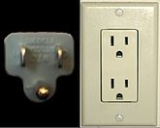
NEMA connectors
Encyclopedia

Mains electricity
Mains is the general-purpose alternating current electric power supply. In the US, electric power is referred to by several names including household power, household electricity, powerline, domestic power, wall power, line power, AC power, city power, street power, and grid power...
in North America
North America
North America is a continent wholly within the Northern Hemisphere and almost wholly within the Western Hemisphere. It is also considered a northern subcontinent of the Americas...
and other countries that use the standards set by the U.S. National Electrical Manufacturers Association
National Electrical Manufacturers Association
is the association of electrical and medical imaging equipment manufacturers. Founded in 1926 and headquartered near Washington, D.C., its approximately manufacture products used in the generation, transmission, distribution, control, and end use of electricity. These products are used in utility,...
. Some types are found in nearly all buildings in the United States. Similar and interchangeable connectors are used in Canada, Mexico, and other countries using the same type of receptacle, although there are some exceptions. NEMA wiring devices are made in current ratings from 15 to 60 ampere
Ampere
The ampere , often shortened to amp, is the SI unit of electric current and is one of the seven SI base units. It is named after André-Marie Ampère , French mathematician and physicist, considered the father of electrodynamics...
s, and electrical potential (voltage) ratings from 125 to 600 volt
Volt
The volt is the SI derived unit for electric potential, electric potential difference, and electromotive force. The volt is named in honor of the Italian physicist Alessandro Volta , who invented the voltaic pile, possibly the first chemical battery.- Definition :A single volt is defined as the...
s. Different combinations of contact blade widths, shapes, orientation, and dimensions give non-interchangeable connectors that are unique to a particular voltage, current capacity, and grounding system. NEMA 1 (two prong) and NEMA 5 (three prong) are used for commonplace domestic equipment; the others are for heavy duty or special purposes. The dimensional standard for electrical connectors is ANSI/NEMA WD–6 and is available from the NEMA website.
NEMA nomenclature
There are two basic classifications of NEMA device: straight-blade and locking. The straight-blade 5–15 and 5–20 are found nearly everywhere in countries using the NEMA standards, and are intended for supplying lighter-duty, general-purpose electrical devices. Twist-locking types are used for heavy industrial and commercial equipment, where increased protection against accidental disconnection is required. Numbers prefixed by L are curved-blade, twist-locking connectors; others are straight blade and non-locking.The numeral preceding the hyphen in NEMA nomenclature indicates the configuration, that is, the number of poles, number of wires, voltage, and whether single- or three-phase. A grounding type of device will be described as two-pole, three-wire; or four-pole, five-wire; etc. A non-grounding device will be two-pole, two wire; or three-pole, three-wire; etc.
The numeral following the hyphen is the rating of the device in amperes. The number is followed by the letter R to indicate a receptacle (female connector) or the letter P to indicate a plug (male connector).
As an example, the 5–15R is the common 125 V two-pole, three-wire receptacle. The L5–15R, while sharing the same electrical rating, is a locking design which is not physically compatible with the straight-blade 5–15 design. The 5–30 has the same two-pole, three-wire configuration and 125 V rating, but is rated 30 A.
Although there are several non-grounding device types in the NEMA standards, only three of them are in widespread use today. These are the two-pole 1–15, still in use in millions of buildings built before the 1960s, and the three-pole 10–30 and 10–50.
The small hole near the end of the power (non-ground) blades of some NEMA plugs is used for convenience in manufacturing; if present it must be of specified diameter and position.
Non-locking connectors
NEMA non-locking connectors all use blades of various flat and folded shapes (except for the round pins used on grounding connectors). The plugs can be detached from the receptacles by pulling back on the plug body. These connector families have been designed so that grounding connectors for 120 V and 208/240 V cannot be accidentally intermated.NEMA wall receptacles can be found installed in any orientation. Neither NEMA nor the U.S. National Electrical Code nor the Canadian Electrical Code
Canadian Electrical Code
The Canadian Electrical Code, CE code, or CSA C22.1 is a standard published by the Canadian Standards Association pertaining to the installation and maintenance of electrical equipment in Canada....
specify a preferred orientation, and different orientations may be found in the same building. When the ground blade of a receptacle is on the bottom, the neutral blade is on the upper left and the hot blade is on the upper right. All descriptions below assume this orientation.
NEMA 1
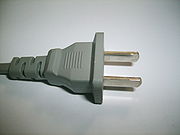
NEMA 2 (obsolete)
All NEMA 2 devices are two-wire non-grounding devices (hot-hot) rated for 250 V maximum. Although standards exist for 2–15, 2–20 and 2–30, this series is obsolete, and only Hubbell still manufactures 2-20 devices.NEMA 5
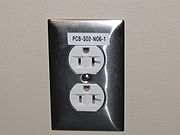
The 5–20P plug has the neutral blade rotated 90° and shifted so its inner edge is approximately 1/2 in from the hot blade. The 5–20R receptacle may have a T-shaped neutral hole, to accept both 5–15P and 5–20P plugs. The 5–30 and 5–50 are larger, with 1 inch between power pins; 5-30 also has a bent neutral blade. All of these are uncommon, as twist-locking plugs are generally used for high-current applications.
Nearly always both current blades on 5–15P plugs are narrow since the ground pin enforces polarity. If the ground pin is removed in order to fit it to a 1–15R outlet or extension cord
Extension cord
An extension cord, power extender, or extension lead is a length of flexible electrical power cable with a plug on one end and one or more sockets on the other end . The term usually refers to mains extensions but is also used to refer to extensions for other types of cabling...
, the live/neutral polarity is lost. 1–15P plugs are also compatible with 5–15P sockets. In this case, the socket retains polarity enforcement. Cheater plug
Cheater plug
A cheater plug, AC ground lifter or three-prong/two-prong adapter is an adapter that allows a NEMA 5-15P grounding-type plug to connect to a NEMA 1-15R non-grounding receptacle . The use of such an adapter avoids the need to replace receptacles, but is potentially hazardous, if the grounding tab...
s, adapters that allow a 5–15P plug to be fitted to a 1–15R outlet, are readily available, but are illegal in some countries. Proper grounding is dependent on the outlet being an ordinary duplex receptacle with a correctly grounded center screw, and the grounding tab of the adapter being connected to that screw.
The 5–15R is by far the most common electrical outlet in North America in buildings built since the mid-twentieth century. It is usually installed in a twin duplex configuration (which may be on a common circuit or with each receptacle on a separate circuit, sometimes switched).
The standard 5–15 (and its 1–15 two prong counterpart) is sometimes called an “Edison plug” in the film and theatre industry, where that name distinguishes it from more specialized theatrical connectors. This is presumably a reference to Thomas Edison
Thomas Edison
Thomas Alva Edison was an American inventor and businessman. He developed many devices that greatly influenced life around the world, including the phonograph, the motion picture camera, and a long-lasting, practical electric light bulb. In addition, he created the world’s first industrial...
or the various Edison utility companies which supply electric power. In the motion picture and TV production industries, an extension cord that uses this type of connector (usually 12 AWG or 10 AWG) is known as a "stinger". Generally, lighting technician
Lighting technician
Lighting technicians are involved with rigging and controlling electric lights for art and entertainment venues or in video, television, or film production. In a theater production, lighting technicians work under the lighting designer and master electrician...
s use these extension cords to deliver power to lights 2000 W and less.
NEMA 6
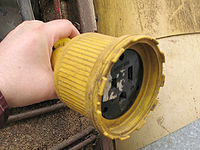
Silo
A silo is a structure for storing bulk materials.Silo may also refer to:* Silo , a 3D modeling software* Silo , a defunct chain of retail electronics stores* SILO , used in Linux...
unloader, and is used with a 6 gauge flexible power cord up to 200 ft (61 m).
NEMA 6 devices, while specified as 250 V, may be used for either 208 V or 240 V circuits, generally depending on whether the building has a three-phase
Three-phase electric power
Three-phase electric power is a common method of alternating-current electric power generation, transmission, and distribution. It is a type of polyphase system and is the most common method used by grids worldwide to transfer power. It is also used to power large motors and other heavy loads...
or split-phase power supply. Visitors to North America should not regard the NEMA 6–20R or 6–30R found in many hotel rooms as a source of 240 V power, since in most cases they are supplied with 208 V, and electrical equipment may be designed for a hot-neutral configuration instead of two hots.
NEMA 10
NEMA 10 devices are a curious throwback to an earlier time. They are classified as 125/250 V non-grounding (hot-hot-neutral), yet they are usually used in a manner that effectively grounds the appliance, though not in a manner consistent with most modern practice.As commonly used, 10–30 and 10–50 plugs have the frame of the appliance grounded through the neutral blade. This was a legal grounding method under the National Electrical Code for electric ranges
Kitchen stove
A kitchen stove, cooking stove, cookstove, or cooker is a kitchen appliance designed for the purpose of cooking food. Kitchen stoves rely on the application of direct heat for the cooking process and may also contain an oven, used for baking.In the industrialized world, as stoves replaced open...
and electric clothes dryers from the 1947 to the 1996 edition. Since North American dryers and ranges have certain parts (timers, lights, fans, etc.) that run on 120 V, this means that the wire used for grounding is also carrying current. Although this is contrary to modern grounding practice, such installations remain common in the United States and are relatively safe, because the larger conductors used are less likely to be broken than the smaller conductors used in ordinary appliance cords, and the current carried is small.
Persons moving their older appliances to newer NEMA-14-equipped buildings (or vice-versa) should have the cords replaced by a qualified electrician.

NEMA 14

All NEMA 14 devices offer two hots, a neutral and a ground, allowing for both 120 V and 240 V (or 120 V and 208 V if the supply system is three-phase
Three-phase electric power
Three-phase electric power is a common method of alternating-current electric power generation, transmission, and distribution. It is a type of polyphase system and is the most common method used by grids worldwide to transfer power. It is also used to power large motors and other heavy loads...
rather than split phase
Split phase
A split-phase electricity distribution system is a 3-wire single-phase distribution system, commonly used in North America for single-family residential and light commercial applications. It is the AC equivalent of the original Edison 3-wire direct current system...
). The 14–30 has a rating of 30 A and an L-shaped neutral blade. The 14–50 has a rating of 50 A and a straight neutral blade sized so that it will not fit in the slot of a 14–30.
NEMA 14–50 devices are frequently found in RV parks, since they are used for shore power connections of larger recreational vehicles. Also, it was formerly common for mobile homes to be connected to utility power via a 14–50 device.
NEMA TT–30
NEMA TT–30 (TT stands for Travel TrailerTravel trailer
A travel trailer or caravan is towed behind a road vehicle to provide a place to sleep which is more comfortable and protected than a tent . It provides the means for people to have their own home on a journey or a vacation, without relying on a motel or hotel, and enables them to stay in places...
) is a 30 A, 125 V recreational vehicle
Recreational vehicle
Recreational vehicle or RV is, in North America, the usual term for a Motor vehicle or trailer equipped with living space and amenities found in a home.-Features:...
standard (hot-neutral-ground) which may also be known as RV 30. It is frequently (and sometimes disastrously) confused for a NEMA 10–30. The RV receptacle is common in nearly all RV park
RV park
A recreational vehicle park or caravan park is a place where people with recreational vehicles can stay overnight, or longer, in alloted spaces known as "pitches"...
s in the United States and Canada, and all but the largest RVs manufactured since the 1970s use this plug. The hot and neutral blades are angled at 45° from vertical and 90 degrees to each other, similar to NEMA 10 devices. The plug is slightly smaller than a NEMA 10 but larger than ordinary 5–15 plugs. The ground pin, however, is round, like those on straight-blade NEMA grounding devices. Referring to the diagram, the orientation is the same as the NEMA 5 plug and socket, with the receptacle neutral on the lower right. Due to the appearance of this plug, many people assume that it is to be wired for 240 V, but this is a 120 V device. Adapters exist with the TT–30 plug on one side and a 5–15 or 5–20 socket on the other side. When the cord is detachable from the RV an L5–30 is usually used on the RV end of the cord.
Twist-locking connectors
Twist-locking connectors were first invented by Harvey Hubbell III in 1938 and “Twist-Lock” remains a registered trademark of Hubbell Incorporated, although the term is used genericallyGenericized trademark
A genericized trademark is a trademark or brand name that has become the colloquial or generic description for, or synonymous with, a general class of product or service, rather than as an indicator of source or affiliation as intended by the trademark's holder...
to refer to NEMA locking connectors manufactured by any company. Locking connectors use curved blades. Once pushed into the receptacle, the plug is twisted and its now-rotated blades latch into the receptacle. To unlatch the plug, the rotation is reversed. The locking coupling makes for a more reliable connection in commercial and industrial settings, where vibration or incidental impact could disconnect a non-locking connector.
Locking connectors come in a variety of standardized configurations that follow the same general naming scheme except that the designations all begin with an “L” for “locking”. Locking connectors are designed so the different voltages and current ratings can not be accidentally intermated.
Many specific types exist; only a few are listed below. Other types include miniature locking connectors, and special purpose connectors for boats, 400 Hz circuits such as used for aircraft, and direct-current use.
One disadvantage of twist-lock connectors is that in the event that the cable is accidentally pulled too hard, rather than the plug falling out of the receptacle, the exposed conductors may come out of the plug, causing dangerous shorts or shock hazards if the circuit is live.
NEMA L5
NEMA L5 connectors are a series of locking connectors with a maximum specified voltage of 125 V. Supply connections are intended to be single-pole hot-neutral-ground circuits with a nominal voltage of 120 V RMS.NEMA L6
NEMA L6 connectors are used with circuits with a maximum specified voltage of 250 V. Supply connections are intended to be two-pole, three wire hot-hot-ground circuit with nominal supply voltage of 240 V or 208 V depending on phase configuration. The L6 connector does not provide a neutral line.L6-20 and L6-30 connectors are commonly found on in-rack power distribution units in countries where the mains supply voltage is greater than 120 V. They are also found in the US for heavy-duty 240V equipment such as welders, where the higher supply voltage allows a lower current draw. These connectors are thus found where industrial equipment or large power tools are commonplace.
NEMA L7
NEMA L7 connectors are used with circuits with a maximum specified voltage of 277 V AC. Supply connections are intended to be single-pole, three-wire hot-neutral-ground circuits with a nominal supply voltage of 265 V.Typically, these connectors are found in commercial or industrial lighting circuits, especially where metal halide lamps are common.
NEMA L8
NEMA L8 connectors are used with circuits with a maximum specified voltage of 480 V AC. Supply connections are intended to be two-pole, three-wire hot-hot-ground circuits with a nominal supply voltage of 460 V.NEMA L9
NEMA L9 connectors are used with circuits with a maximum specified voltage of 600 V AC. Supply connections are intended to be two-pole, three-wire hot-hot-ground circuits with a nominal supply voltage of 600 V.NEMA L14
NEMA L14 connectors are used with circuits with a maximum specified voltage of 125/250 V. Supply connections are intended to be two-pole, four-wire hot-hot-neutral-ground circuits with a nominal supply voltages of 240 V or 208 V hot-to-hot and 120 V hot-to-neutral.These connectors are common on household backup generators, and on racks of power amplifiers in large audio systems.
NEMA L15
NEMA L15 connectors are used with circuits with a maximum specified voltage of 250 V AC. Supply connections are intended to be three-phase, four-wire L-L-L-G circuits with a nominal supply voltage of 208 V L-L (wye three phase) or 240 V L-L (delta three phase).NEMA L16
NEMA L16 connectors are used with circuits with a maximum specified voltage of 480 V AC. Supply connections are intended to be three-phase, four-wire L-L-L-G circuits with a nominal supply voltage of 460 V.NEMA L17
NEMA L17 connectors are used with circuits with a maximum specified voltage of 600 V AC. Supply connections are intended to be three-phase, four-wire L-L-L-G circuits with a nominal supply voltage of 600 V.NEMA L18
NEMA L18 connectors are used with circuits with a maximum specified voltage of 120/208 V AC. Supply connections are intended to be wye three-phase, four-wire L-L-L-N circuits with a nominal supply voltage of 208 V L-L and 120 V L-N.NEMA L21
NEMA L21 connectors are used with circuits with a maximum specified voltage of 120/208 V AC. Supply connections are intended to be wye three-phase, five-wire L-L-L-N-G circuits with a nominal supply voltage of 208 V L-L and 120 V L-N.These three-phase connections include neutral and ground. The pin in the middle is ground, and the blade with a right angle on the tab is neutral.
NEMA L22
NEMA L22 connectors are used with circuits with a maximum specified voltage of 277/480 V AC. Supply connections are intended to be three-phase, five-wire L-L-L-N-G circuits with a nominal supply voltage of 460 V L-L and 265 V L-N.NEMA L23
NEMA L23 connectors are used with circuits with a maximum specified voltage of 347/600 V AC. Supply connections are intended to be three-phase, five-wire L-L-L-N-G circuits with a nominal supply voltage of 600 V L-L and 347 V L-N.Special safety features
Over time, electrical codes in the U.S. and Canada began to require special safety features in the basic NEMA 5-15R and 5-20R configurations to address specific electric shock hazard concerns. The safety features listed below are not mutually exclusive; tamper resistant GFCI receptacle outlets are sold.Ground fault circuit interrupter (GFCI) receptacles
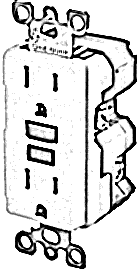
Residual-current device
A Residual Current Device is a generic term covering both RCCBs and RCBOs.A Residual-Current Circuit Breaker is an electrical wiring device that disconnects a circuit whenever it detects that the electric current is not balanced between the energized conductor and the return neutral conductor...
s and have Test and Reset buttons (and sometimes an indicator light). In the U.S. and Canada, they are required in many potentially wet locations, including outside outlets, bathrooms, some places in kitchens, basements, and crawl spaces. They work by comparing the current going out on the hot line, to the current returning on the neutral line, and will disconnect the circuit if the difference exceeds 4–6 milliamperes
Ampere
The ampere , often shortened to amp, is the SI unit of electric current and is one of the seven SI base units. It is named after André-Marie Ampère , French mathematician and physicist, considered the father of electrodynamics...
. They are cheaper than GFCI circuit breakers and can be wired to feed additional "downstream" outlets so that putting one GFCI receptacle in a circuit will protect all the plugs, lights, and switches downstream from it. They are also recommended for power tool outlets and locations where children might insert conductive objects into the receptacles.
Tamper-resistant receptacles
Starting with the 2008 National Electrical Code and the 2009 Canadian Electrical Code, listedUnderwriters Laboratories
Underwriters Laboratories Inc. is an independent product safety certification organization. Established in 1894, the company has its headquarters in Northbrook, Illinois. UL develops standards and test procedures for products, materials, components, assemblies, tools and equipment, chiefly dealing...
tamper-resistant receptacles that address electric shock hazards to children must now be installed in almost all areas of new or renovated dwellings. According to statistics cited by the NFPA
National Fire Protection Association
The National Fire Protection Association is a United States trade association that creates and maintains private, copywrited, standards and codes for usage and adoption by local governments...
, the code change adds only $40 to the cost of building an average, 75-receptacle home in the U.S., yet prevents shock hazards to a child that sticks a single, metal object into the receptacle. The new receptacles are expected to reduce the number of electric shocks to children because inserting a normal, two-prong electrical plug applies pressure on both sides of the outlet to open an internal, spring-loaded shutter, but a foreign object fails to do so and therefore does not make contact with the live electrical contacts. However, the device can still be defeated by inserting two objects simultaneously. Despite its weaknesses, the tamper-resistant receptacle is believed to be vastly superior to protective plastic outlet caps (they need to be individually installed to each receptacle and are a choking
Choking
Choking is the mechanical obstruction of the flow of air from the environment into the lungs. Choking prevents breathing, and can be partial or complete, with partial choking allowing some, although inadequate, flow of air into the lungs. Prolonged or complete choking results in asphyxia which...
hazard when removed) and sliding covers that children easily learn to defeat.
Leak-current detection and interruption (LCDI) plugs
Because portable air conditioners have caused many electrical fires, those sold in the United States now must have leak-current detection and interruption (LCDI) plugs. The cords have a fine wire mesh around the conductors and circuitry to detect any current leaking from the conductors to the mesh, which would happen if the cord were damaged or frayed. These could be NEMA 5–15, 5–20, 6–15, 6–20 or 6–30 plugs, depending on the air conditioner. The plug is equipped with “Test” and “Reset” buttons on the housing.Color code
The color of a device neither identifies its voltage class nor power system. Because the colors are not regulated by national standards, the purpose of color-coding a receptacle is set by the building owner. In this case, building owners may select brown, ivory, white, almond, grey, and black receptacles in the 5–15 configuration to blend with the decor of a room.However, while colors are not regulated by NEMA, some industries utilize colors for certain applications:
- Blue receptacles may indicate built-in surge suppressors.
- A red receptacle may indicate a special-service outlet such as one connected to an emergency standby power source.
- At least one manufacturer makes a yellow receptacle which identifies it as corrosion-resistant.
- An orange receptacle in telecommunicationTelecommunicationTelecommunication is the transmission of information over significant distances to communicate. In earlier times, telecommunications involved the use of visual signals, such as beacons, smoke signals, semaphore telegraphs, signal flags, and optical heliographs, or audio messages via coded...
or data centerData centerA data center is a facility used to house computer systems and associated components, such as telecommunications and storage systems...
usage may indicate the receptacle or plate pair is on a dedicated circuit, and not shared with other receptacles. This information, along with receptacle type (often 5-20R, L5-20R or L5-30R in North America) may be used to determine how much equipment may safely be installed. - A receptacle with a green dot is a so-called “hospital grade” device; such devices are tested to survive harder use than wiring devices intended for residential or commercial purposes.
- A receptacle with an orange triangle is an isolated groundIsolated groundIsolated ground means the use of a local ground connection with a supply, one of the common earthing arrangements used with domestic mains supplies....
device, where the grounding pin of the receptacle is connected to ground independently of the frame of the receptacle and wiring outlet box. The receptacle itself may be any color, though older common convention in the United States specified an orange receptacle rather than an orange triangle on the receptacle.
Break-away tabs
Duplex receptacles usually have break-away tabs to separate the top and bottom halves so that the two outlets can be placed on separate circuits. This may allow for one switched outlet for a lamp or for two circuits to be used when heavy loads are anticipated. Two branch circuits may share a neutral terminating on duplex receptacles, a condition sometimes referred to as "split-wiring", "split-receptacle", or "half-split".Neglecting to break the tabs when replacing a split-receptacle can result in a 240V line-to-line fault.
See also
- AC power plugs and sockets
- AmpereAmpereThe ampere , often shortened to amp, is the SI unit of electric current and is one of the seven SI base units. It is named after André-Marie Ampère , French mathematician and physicist, considered the father of electrodynamics...
- Canadian Electrical CodeCanadian Electrical CodeThe Canadian Electrical Code, CE code, or CSA C22.1 is a standard published by the Canadian Standards Association pertaining to the installation and maintenance of electrical equipment in Canada....
- IEC 60320, an international standard for power connectors
- List of countries with mains power plugs, voltages and frequencies
- National Building Code of CanadaNational Building Code of CanadaThe National Building Code of Canada is the model building code of Canada. It is issued by the Institute for Research In Construction ], a part of the National Research Council of Canada...
- Underwriters LaboratoriesUnderwriters LaboratoriesUnderwriters Laboratories Inc. is an independent product safety certification organization. Established in 1894, the company has its headquarters in Northbrook, Illinois. UL develops standards and test procedures for products, materials, components, assemblies, tools and equipment, chiefly dealing...
- US National Electrical Code
- VoltVoltThe volt is the SI derived unit for electric potential, electric potential difference, and electromotive force. The volt is named in honor of the Italian physicist Alessandro Volta , who invented the voltaic pile, possibly the first chemical battery.- Definition :A single volt is defined as the...
External links
- Georgia State University - Physics Department - Household Wiring ~ Polarized Receptacles (diagram)
- NoOutage.com - NEMA Configurations (socket configurations)
- Power Cabling - NEMA Configurations (socket configurations)
- Stay Online - NEMA Plug & Receptacle Configurations Reference Chart (Straight Blade) (socket configurations)
- Stay Online - NEMA Plug & Receptacle Configurations Reference Chart (Locking) (socket configurations)
- System Connection - Power Cord NEMA Mold Chart (socket configurations)
- NEMA Configurations for General Purpose Non-Locking Connectors (socket configurations, concise)

